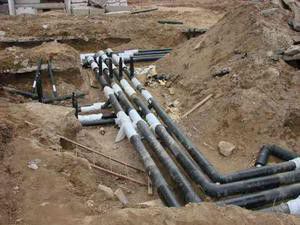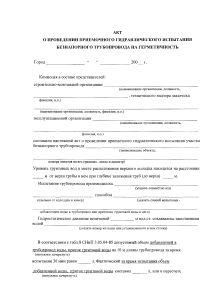Hydraulic tests are carried out after the completion of installation work, they are mandatory for pressure and non-pressure water supply networks. To carry out the tests, a pump is required that pumps an increased pressure in the water supply system, which reveals defects. The data obtained are entered into the water supply test report. Only after signing the act can the water supply be used.
Purpose and order of tests

Hydraulic tests of water supply and sewerage systems are carried out to check the tightness, reliability of the water supply and the detection of defective parts. Testing is prescribed before the commissioning of a newly constructed network or after reconstruction (overhaul). All detected defects are immediately corrected, and tests are repeated until a satisfactory result is obtained. The tests are carried out twice: first preliminary, after them final.
At the first stage, water is pumped into the water supply system under pressure, the pressure should be one and a half times higher than the working one. Preliminary hydraulic tests of water supply pipelines are assigned with full access to the surface and underground parts of the pipeline, prior to the installation of plumbing fixtures.
Testing is scheduled before the final finishing of the premises. Hydraulic tests of sewerage and water supply systems are carried out by specialists from the plumbing service.
Before the final stage of hydraulic testing of water supply, underground sections are closed, all installation work on the section is being completed, but plumbing fixtures have not yet been installed. The exits are covered with plugs. During hydraulic tests of cold water supply, the pressure in the lines is increased by 1.3 times in comparison with the working one.
- Hydraulic tests of plastic water supply pipelines are allowed to be carried out a day after the end of installation, at a positive temperature;
- To carry out hydraulic tests of the weirs in the house, the pipes are completely filled with water to the top of the risers. Preliminary, they visually examine the condition of the pipes and correct noticeable shortcomings. If a completely filled weir system does not flow for 20 minutes, and the water remains at the marked level, the system has successfully passed the test.
Test conditions

It is necessary to carry out hydraulic tests of water supply and sewerage systems with full responsibility, realizing the complexity of the procedure. The test result largely depends on the literacy of their conduct. Therefore, they are trusted only by specialists who know the security measures and the requirements for such checks.
- The temperature indoors or outdoors (if the external water supply is checked) is not lower than +5 degrees;
- The water supply system is filled gradually, starting from the main section. Then water is poured into risers and small local networks;
- First, the lower floors are filled, gradually rising higher and higher. This is necessary to displace air from the pipes and prevent the formation of air pockets;
- At the end of the hydraulic tests, the used water is drained from the water supply and sewerage system;
- During hydraulic tests of hot water supply, the temperature is measured at the extreme sections of the system. Water of the design temperature is poured into the system;
- During hydraulic tests of hot water supply, the condition of heated towel rails in bathrooms is tested;
- If it is necessary to test the efficiency of the water supply system, all points of use in the riser are simultaneously turned on. This test phase is optional.
Preliminary test progress
The procedure for conducting a preliminary hydraulic test is regulated by the Building Norms and Rules:
- The water supply is filled and left unpressurized for two hours.
- Increased pressure is slowly created for half an hour. Then you can check for leaks at the joints.
- The head is reduced to the calculated indicators, the state of the track is investigated.
- Under such a pressure of water, the route remains for 30 minutes or more to stabilize the deformed shape of the pipes.
- The inlet taps are closed and, with the help of a pressure pump, the water is slowly drained from the pipes.
- The track is checked for leaks and noticeable problems.
The water supply system has successfully passed the checks in the case when no leaks were detected at an increased pressure, the connections and fastening elements are intact.
Before starting a hydraulic test of a water supply system in an apartment building, you should find out the nominal working pressure, check with the pressure limits of the devices (collectors, hoses, filters, sensors).
Final test progress

In multi-apartment residential buildings, the final hydraulic test of the cold water pipe is carried out after the installation of plumbing devices:
- A working pressure is injected in the water supply system and kept for two hours. If the head decreases by 0.02 MPa, it is raised to the initial mark.
- In 10 minutes, the pressure is increased to the test parameters and held for two hours.
The hydraulic tests of the cold water supply system are considered successful if the leakage is not higher than the readings in the table.
| Dexternal pipe diameter, cm | Permitted leak, liter \ min | |
| For welded joints | For connections on gaskets (sockets) | |
| 6,3-7,5 | 0.2 to 0.24 | from 0.3 to 0.5 |
| 9-11 | 0.26 to 0.28 | from 0.6 to 0.7 |
| 12,5-14 | from 0.35 to 0.38 | from 0.9 to 0.95 |
| 16-18 | from 0.42 to 0.6 | from 1.05 to 1.2 |
| 20 | 0,56 | up to 1.4 |
| 25 | 0,7 | up to 1.55 |
| 28 | 0,8 | up to 1.6 |
| 31,5 | 0,85 | up to 1.7 |
| 35,5 | 0,9 | up to 1.8 |
| 40-45 | from 1.1 to 0.5 | from 1.95 to 2.1 |
| 50-56 | from 1.1 to 1.15 | from 2.2 to 2.3 |
| 63 | 1,2 | up to 2.4 |
| 71 | 1,3 | up to 2.55 |
| 80 | 1,35 | up to 2.7 |
| 90 | 1,45 | up to 2.9 |
| 100 | 1,5 | until 3 |
| 120 | 1,6 | until 3 |
Table 1. Allowed volumes of leaks on a section of a water pipeline with a duration of 1 km
The data obtained as a result of hydraulic tests are entered as detailed as possible into the acceptance certificate of the water supply system. This also includes information about alterations and repairs made during the tests. The water supply test act is proof of the quality and excellent condition of the water supply system, readiness for operation.
At the end of the hydraulic tests, the following documents are required to commission the cold or hot water supply system: working materials with notes on the features of the installation of the water supply system and the coincidence of the final result with the project, a description of the changes; hydraulic test report; an act describing the hidden works.
Video on how to modify a cheap Chinese pump for crimping:









It is necessary to test the water supply system of the enterprise, how to do it?
You need an outsourcing company that specializes in this.
For the test, a technical specification, an act of work performed and a report on the verification performed are drawn up.
Terms, prices and other services must be negotiated with each company separately.
We recommend that you initially contact several, and then choose the most suitable contractor.